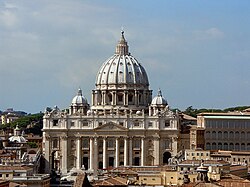Latin Catholics
|
Latin Church |
|
|---|---|
| Latin: Ecclesia Latina | |

|
|
| Type | Particular church (sui iuris) |
| Classification | Catholic |
| Orientation | Western Christianity |
| Polity | Episcopal |
| Head | Pope Francis |
| Language | Ecclesiastical Latin |
| Liturgy | Latin liturgical rites |
| Headquarters | Vatican City (located within Rome, Italy) |
| Origin | 1st century, according to Catholic tradition |
| Separations |
|
| Members | 1.197 billion (December 2011) |
| Other name(s) | Western Church |
| Official website | Holy See |
The Latin Church, sometimes called the Western Church, is the largest particular church sui iuris in full communion with the Pope and the rest of the Catholic Church, tracing its history to the earliest days of Christianity. Employing the Latin liturgical rites, with 1.197 billion members (2011), the Latin Church is the original and still major part of Western Christianity. It is headquartered in the Vatican City, enclaved in Rome, Italy.
Historically, the Latin Church has been viewed as one of the five patriarchates – the Pentarchy – of early Christianity, along with the Patriarchs of Constantinople, Alexandria, Antioch, and Jerusalem. Due to geographic and cultural considerations, the latter patriarchates developed into churches with distinct Eastern Christian traditions. The majority of Eastern Christian churches broke full communion with the bishop of Rome and the Latin Church, following various theological and leadership disputes, notably in the centuries following the Council of Chalcedon in 451 AD (Oriental Orthodoxy), and the East-West Schism of 1054 (Eastern Orthodoxy). The Protestant Reformation of the 16th century saw an analoguos schism. Until 2005, the Pope claimed the title "Patriarch of the West"; Pope Benedict XVI lifted this title for ecumenical purposes while continuing to exercise a direct patriarchal role over the Latin Church.
...
Wikipedia
